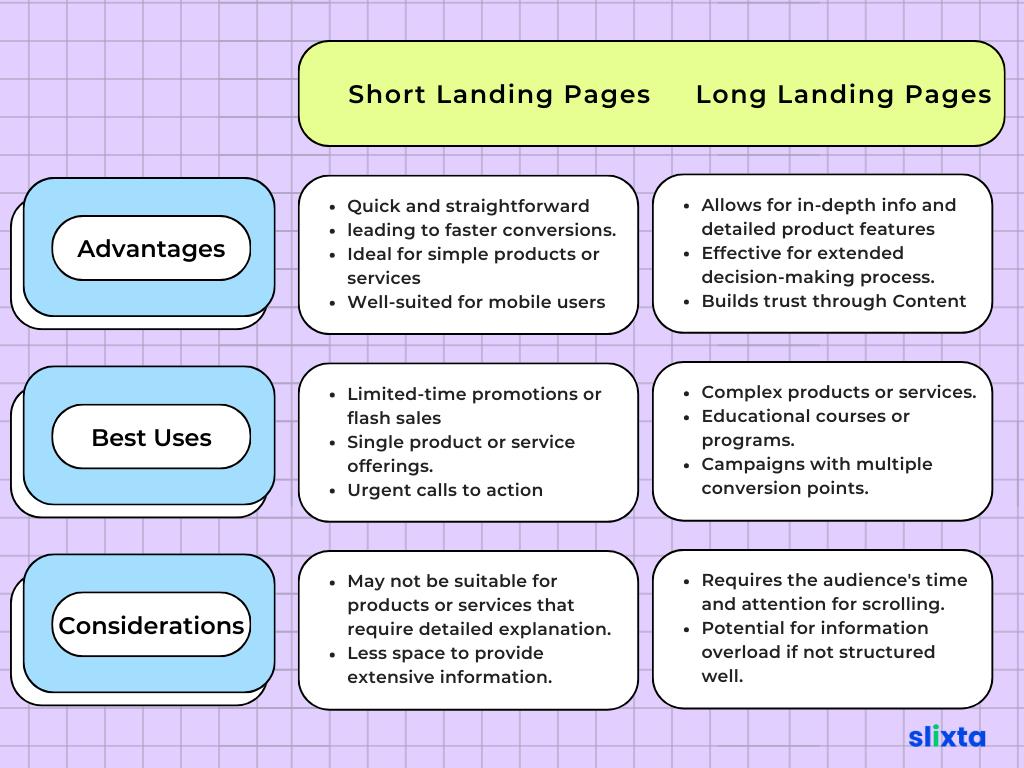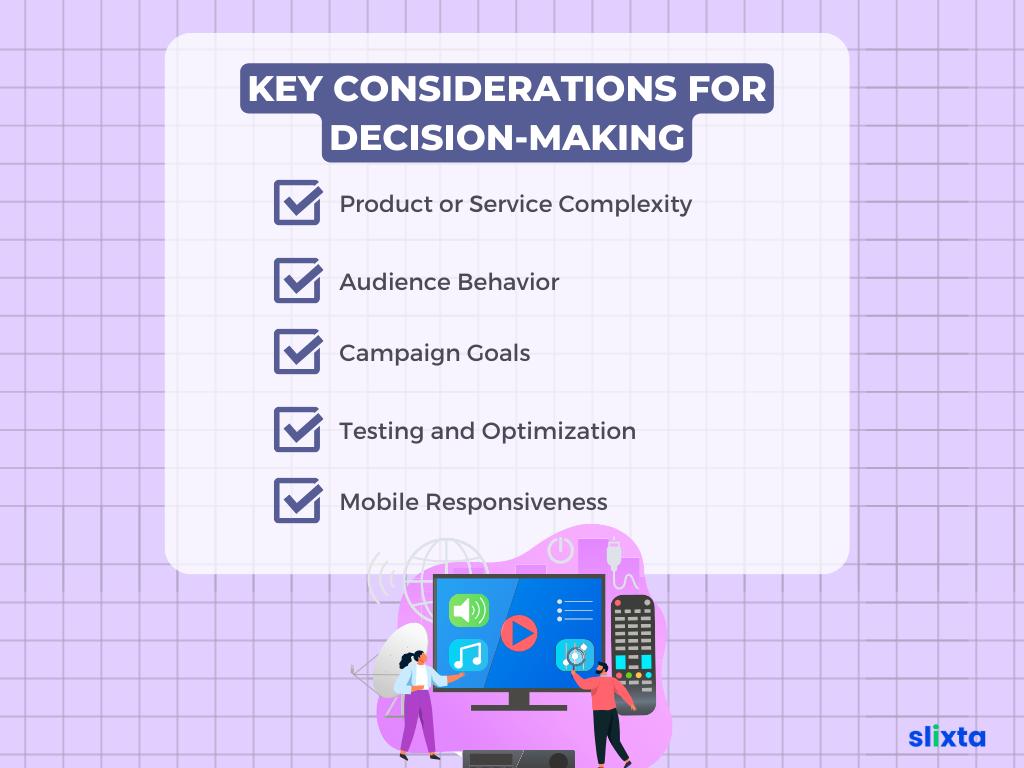Striking the right balance in landing page copy involves considering the audience's preferences and the complexity of the message. While concise copy is generally favored for clarity, longer copy may be necessary for more detailed or nuanced messages. Testing different lengths, focusing on clarity and relevance, and aligning with the audience's expectations are key strategies for finding the optimal length in landing page copy.
The average attention span of an internet user is just a few seconds, akin to the blink of an eye. In the quest for user engagement, businesses find themselves grappling with a critical dilemma - how much information is just enough, and how much is too much?
This quandary brings us to the intriguing crossroads of copywriting strategy – does the length of your landing page copy truly matter?
It's not just about the words on the screen; it's about sculpting a narrative that captivates, informs, and ultimately propels users toward the coveted conversion.
In order to help you find the answer to that question, here are a few things to keep in mind.
Why Landing Page Copy is Crucial
Where users have a multitude of options at their fingertips, a well-crafted landing page can make all the difference between capturing a visitor's attention and losing them. The landing page serves as a digital storefront, providing a first impression that can either draw a potential customer in or prompt them to navigate away.
The importance of landing page copy lies in its ability to convey a brand's message, showcase its value proposition, and guide visitors toward a desired action.
It's the virtual handshake between a business and its audience, offering a glimpse into the products, services, or information available. Effective landing page copy can establish trust, build credibility, and ultimately drive conversions.
The Role of Length in Influencing User Engagement
In landing page optimization, the question of copy length emerges as a pivotal consideration. Striking the right balance is crucial, as the length of the copy directly impacts user engagement.
Too brief, and the message may be incomplete, leaving visitors confused or unconvinced. Too lengthy, and attention spans may wane, leading to a potential loss of interest.
Understanding the role of length in influencing user engagement involves navigating the delicate equilibrium between providing sufficient information to inform and persuade while ensuring the content remains concise and digestible.
Users often prefer content that is clear, compelling, and easy to consume. Therefore, finding the optimal length for landing page copy becomes a strategic challenge for businesses seeking to maximize the impact of their online presence.
Long or Short Copy for Landing Pages?
The effectiveness of a long or short landing page depends on various factors, and there isn't a one-size-fits-all answer. Both long and short landing pages have their advantages and are suitable for different scenarios.
Short Landing Pages
Short landing pages are a valuable asset for capturing attention and driving rapid conversions. They excel when promoting straightforward products or services, providing just enough information to entice without overwhelming the audience. Particularly beneficial for mobile users, these pages cater to those seeking a streamlined experience, avoiding extensive scrolling.
These landing pages find their prime use in limited-time promotions or flash sales, where their concise nature effectively conveys urgency, prompting swift user action. Similarly, when focused on a single product or service, short landing pages ensure that visitors remain undistracted, enhancing the chances of conversion. Their succinct format is particularly well-suited for urgent calls to action, encouraging immediate responses.
They may not be suitable for products or services requiring detailed explanations, as the limited space might lead to confusion. Addressing potential objections becomes challenging with less room, and for offerings demanding extensive information, longer formats may be more appropriate.
Advantages
- Quick and straightforward, leading to faster conversions.
- Ideal for simple products or services.
- Well-suited for mobile users who may not want to scroll extensively.
Best Uses
- Limited-time promotions or flash sales.
- Single product or service offerings.
- Urgent calls to action.
Considerations
- May not be suitable for products or services that require detailed explanation.
- Less space to address potential objections or provide extensive information.
Long Landing Pages
Long landing pages are a versatile asset in online marketing, offering the space to provide in-depth information and detailed features of products or services. They excel in scenarios involving extended decision-making processes, accommodating the need for comprehensive information to assist potential customers in making informed choices.
Beyond functionality, these pages are instrumental in building trust through storytelling, testimonials, and comprehensive content. Ideal for promoting complex products, educational courses, and campaigns with multiple conversion points, long landing pages facilitate nuanced understanding and engagement across diverse audience segments.
However, it's crucial to consider that they require users to invest time and attention in scrolling, emphasizing the need for a user-friendly layout. Additionally, without careful structuring, there is a potential risk of information overload, underscoring the importance of striking a balance between detailed content and readability to optimize user experience.
Advantages
- Allows for in-depth information and detailed product features.
- Effective for products or services with a more extended decision-making process.
- Builds trust through storytelling, testimonials, and comprehensive content.
Best Uses
- Complex products or services.
- Educational courses or programs.
- Campaigns with multiple conversion points.
Considerations
- Requires the audience's time and attention to scroll.
- Potential for information overload if not structured well.

Key Considerations for Decision-Making

Product or Service Complexity
- Choose a long landing page if your offering requires a detailed explanation and addresses multiple aspects.
- Opt for a short landing page for straightforward products or services.
- Example: If you're promoting a simple mobile app with basic functionality, a short landing page showcasing key features and a compelling call-to-action might be more effective. However, if you're marketing sophisticated project management software, a long landing page could be beneficial to explain its extensive features, integrations, and benefits.
Audience Behavior
- Understand your target audience's preferences—some users prefer concise information, while others may appreciate a more detailed presentation.
- Example: For a target audience that prefers quick information and is likely to make impulsive decisions, a short landing page featuring a limited-time offer with a clear value proposition might be suitable. On the other hand, if your audience typically conducts thorough research before making a decision, a long landing page with detailed information and testimonials may be more appealing.
Campaign Goals
- Consider your campaign objectives. If the goal is to capture quick conversions, a short landing page might be more effective.
- For nurturing leads through education, a long landing page may be appropriate.
- Example: If your primary goal is to drive immediate sales during a flash sale, a short landing page with a countdown timer and a concise offer might be effective. However, if your goal is to generate leads for a high-ticket consulting service, a long landing page that educates the audience about the service's value and benefits may be more appropriate.
Testing and Optimization
- Conduct A/B testing to determine which type of landing page resonates better with your audience.
- Continuously optimize based on performance metrics.
Mobile Responsiveness
- Ensure that your chosen landing page type is mobile-friendly. Short pages may be more suitable for mobile users, but it's essential to provide a good user experience on all devices.
- Example: If a significant portion of your audience accesses your landing pages on mobile devices, a short and visually engaging landing page that loads quickly on smartphones may be preferable. Ensuring a seamless user experience on various devices is crucial, and mobile responsiveness should be a priority in the design and optimization process.
Conclusion
It became evident that there's no one-size-fits-all solution. Each approach, whether concise or comprehensive, brings its own set of advantages and considerations.
Short landing pages emerged as the sprinters of the digital world—swift, compelling, and perfect for immediate conversions. Ideal for time-sensitive promotions and straightforward offerings, they cater to audiences seeking quick engagement without extensive scrolling.
On the other side of the spectrum, long landing pages revealed themselves as marathoners, accommodating the needs of audiences craving detailed insights and comprehensive information. Particularly effective for complex products, educational content, and campaigns with multiple conversion points, these pages build trust through storytelling and thorough exploration.
In conclusion, the secret to the perfect landing page lies in understanding your unique context, testing both approaches and continuously optimizing based on real-time data. As you embark on crafting your landing pages, may you find the sweet spot that captures attention, engages hearts, and converts visitors into loyal advocates.
For more valuable insights and information, check out these recommended blogs:

